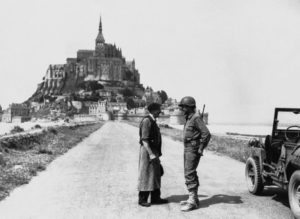Mont-Saint-Michel (Manche)
The cities of Normandy during the 1944 battles
An American soldier and a Norman civilian pose for the photographer in front of Mont Saint Michel in 1944.
Photo : US National Archives
- Liberation : 1st August 1944
- Units involved :
![]() 83rd Infantry Division
83rd Infantry Division
- History:
The Germans reached Mont-Saint-Michel on 20 June 1940. The Germans then decided to restrict the usual tourism to the site, in order to secure the coastal areas. Although the famous ‘Wonder’ was of no real tactical interest, it was nonetheless used by the occupying forces to set up a radar acquisition system in the spire of the abbey. Operated daily by five transmitters, it was responsible for spotting air formations in the area. The permanent inhabitants were grouped together in the Gabriel tower and the ‘crypt of the large pillars’.
Many German officers initially reserved the right to visit the mountain: they were soon followed by hundreds of thousands of soldiers (325,000 in total), who paid an entrance fee of five francs. Every year, a thousand Frenchmen were allowed to visit the mountain: they were checked by a team of German customs officers who were permanently stationed on the rock.
When the gateway to Brittany was opened with the liberation of Avranches and Pontaubault on 31 July 1944, the 6th Armoured Division headed for Pontorson and shook the defensive lines, hastily improvised by scattered elements of the 91. Infantry Division. In its wake, the 83rd Infantry Division was tasked with reducing isolated resistance. That same day, the Germans left the ‘Wonder’ at 10 a.m. and continued to evacuate it until early evening.
On 1 August, a Jeep from the 83rd Infantry Division, carrying three war correspondents, crossed the bay and approached the mountain at around 4pm. On board were Norman Clark, working for the London News Chronicle, James H. Wellard, (Chicago Sun-Times) and Cornelius Ryan (London Daily Telegraph): three curious people who couldn’t resist discovering this magnificent site, spared by the war. They were greeted by the cheers of the locals, who immediately sang the ‘Marseillaise’ from the ramparts.
A few days later, on 6 August, three other correspondents went to Mont-Saint-Michel: the photographer Robert Capa, the writer Ernest M. Hemingway and William Walton, correspondent for Time Magazine. Hemingway, who knew the place from his pre-war visits, advised his comrades to sit down with him at a table in La Mère Poulard restaurant. Another famous actor of the period, General Patton, was also familiar with the rocky islet, having stopped there on his honeymoon in 1913.
Mont-Saint-Michel map:

